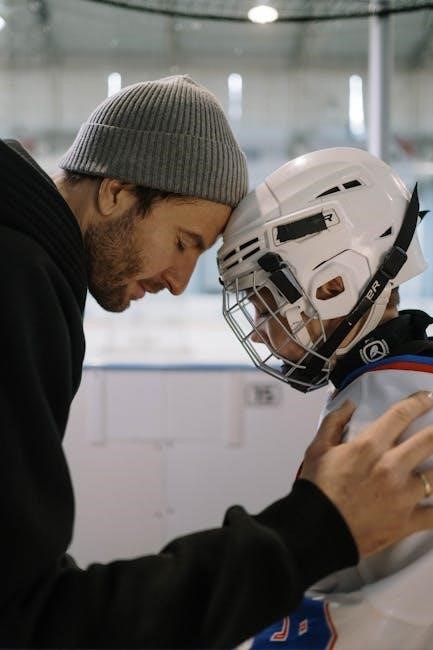Understanding fractures in children is crucial for parents. Their growing bones are resilient but can break. Recognizing signs like pain, swelling, or limited movement ensures timely treatment and better recovery.
Understanding Fractures and Their Impact on Children
Fractures in children differ from those in adults due to their developing bones and growth plates, which are more flexible but also vulnerable. Growth plates, responsible for bone growth, can be easily damaged, potentially affecting future development. Common types include buckle, stress, and complete fractures, each requiring varying levels of care. Early diagnosis is crucial, as delays can lead to complications like improper healing. Understanding the emotional and physical impact on children is vital, as fractures can cause pain, anxiety, and temporary lifestyle changes. Parents play a key role in ensuring proper treatment and supporting their child’s recovery, fostering both physical healing and emotional well-being. This knowledge helps parents navigate the challenges of dealing with fractures, ensuring the best possible outcomes for their child’s health and development.

Common Causes of Fractures in Children
Fractures in children often result from accidental falls, sports injuries, or overuse during physical activities. Active play and high-energy lifestyles can increase the risk, as children may experience twists, bends, or direct blows to their bones. Growth spurts can also make bones temporarily more susceptible to injury due to rapid changes in bone structure. Improper training techniques, inadequate equipment, or unsafe environments further contribute to fracture risks. Additionally, non-accidental injuries, though less common, are a serious concern and require immediate attention. Understanding these causes helps parents identify potential risks and take preventive measures to protect their children from unnecessary harm. Awareness and vigilance are key to ensuring a safe and healthy environment for kids to thrive.

Prevention Strategies
Preventing fractures in children involves creating a safe environment, ensuring proper nutrition, and encouraging safe play. Implementing safety measures, like padding play areas and using protective gear during sports, can significantly reduce risks. Additionally, teaching children to avoid risky behaviors and promoting a balanced diet rich in calcium and vitamin D supports strong bone development. By taking these proactive steps, parents can help protect their children from fractures and foster long-term bone health.
Safety Measures to Reduce the Risk of Fractures
Implementing safety measures is key to preventing fractures in children. Ensure their environment is hazard-free by securing heavy furniture, padding sharp edges, and removing tripping hazards. Encourage the use of protective gear during sports or high-risk activities, such as helmets, knee pads, and elbow pads. Teach children to play safely and avoid risky behaviors. Supervise outdoor play to minimize accidents. Installing safety gates at stairs and ensuring proper lighting in hallways can also reduce fall risks. By creating a secure and aware environment, parents can significantly lower the likelihood of fractures and help their children stay safe and active.
Importance of Proper Nutrition for Bone Health
Proper nutrition plays a vital role in maintaining strong bones and reducing fracture risks in children. A diet rich in calcium and vitamin D is essential for bone development, as these nutrients help build dense bones and support growth. Foods like milk, cheese, leafy greens, and fortified cereals are excellent sources. Protein also contributes to bone health by promoting collagen production, which strengthens bone structure. Avoiding sugary and processed foods can prevent calcium leaching from bones. Encouraging a balanced diet ensures optimal bone growth and minimizes fracture risks. Parents should also consider supplements if dietary intake is insufficient. A well-nourished child is better equipped to recover from injuries and maintain long-term bone health, making nutrition a cornerstone of fracture prevention strategies.

Diagnosis Process
Diagnosing fractures in children involves X-rays, MRIs, or physical exams to assess bone integrity. Signs like swelling, pain, or limited movement often indicate a fracture.

Recognizing the Signs and Symptoms of a Fracture
Recognizing fractures in children is vital for early intervention. Common signs include swelling, pain, limited movement, and deformity near the injured area. Bruising or redness may also appear. Children may refuse to bear weight on the affected limb or exhibit difficulty moving a limb. In some cases, a fracture may not be immediately obvious, especially in younger children who cannot clearly communicate their pain. Parents should monitor for unusual behavior, such as guarding or avoiding the use of a specific limb. If a fracture is suspected, seek immediate medical attention to prevent complications. Early recognition ensures proper treatment and supports optimal recovery. Always trust your instincts if your child appears injured or in distress.
Role of Medical Imaging in Diagnosing Fractures
Medical imaging plays a critical role in accurately diagnosing fractures in children. X-rays are the most commonly used tool, providing clear images of bone structure to identify breaks. For younger children, low-radiation X-rays are often used to minimize exposure. In complex cases, MRIs or CT scans may be recommended to assess soft tissue damage or growth plate injuries. Ultrasound is another radiation-free option, particularly effective for detecting subtle fractures like buckle fractures. These imaging techniques help confirm the severity and location of the fracture, guiding treatment decisions. Early and accurate diagnosis ensures appropriate care, whether it’s a cast, brace, or surgical intervention. Parents should consult healthcare professionals to determine the best imaging approach for their child, ensuring both safety and effectiveness in fracture assessment.

Treatment Approaches

Treatment for fractures in children often involves casts or braces to immobilize the bone. Surgery may be required for more complex breaks, ensuring proper healing and alignment.
Non-Surgical Treatment Options for Fractures
For many childhood fractures, non-surgical treatments are effective. Casting or bracing is commonly used to immobilize the bone, allowing it to heal properly. Splints may be used for minor fractures or in the initial stages before a cast is applied. Pain management is crucial, often involving over-the-counter medications like acetaminophen or ibuprofen. In some cases, physical therapy is recommended after immobilization to restore strength and mobility. These methods are preferred for less complex fractures, ensuring a full recovery without invasive procedures. Proper care and adherence to medical advice are key to successful healing. Non-surgical approaches are often sufficient for children, as their bones tend to heal faster than adults.
Surgical Interventions for Complex Fractures
Surgical interventions are necessary for complex fractures that cannot heal properly with non-surgical treatments. In children, elastic stable intramedullary nailing (ESIN) is a common method for long bone fractures, allowing for minimal invasion while maintaining growth potential. Surgery is often required when fractures are severely displaced, unstable, or involve growth plates. Pediatric orthopedic surgeons specialize in treating these cases, ensuring proper alignment and stabilization. Surgical options may include pins, plates, or rods to hold the bone in place during healing. These procedures are tailored to the child’s age and fracture type, minimizing long-term complications. Early surgical intervention can prevent deformities and ensure optimal recovery, making it a critical option for complex fractures in children.

Recovery Tips
Ensure your child gets adequate rest, proper nutrition, and avoids overexertion. Monitor activity levels to prevent reinjury and provide emotional support to aid their physical and mental recovery.
Effective Home Care for Recovery
Ensuring proper rest and immobilization is key to healing. Use casts, splints, or braces as directed by healthcare providers to protect the fracture site. Manage pain with prescribed medications or over-the-counter options like acetaminophen, following dosage guidelines. Maintain a balanced diet rich in calcium and vitamin D to promote bone regeneration. Keep the affected area elevated to reduce swelling and improve circulation.
Monitor for signs of complications, such as increased redness, swelling, or pain, and seek medical attention if they occur. Encourage your child to follow activity restrictions to avoid reinjury. Provide emotional support and reassurance to help them cope with recovery. Regular follow-ups with the doctor ensure the fracture is healing correctly. By adhering to these steps, you can create a nurturing environment for your child’s full recovery.
Rehabilitation Exercises for Full Recovery
Gentle exercises are essential for restoring strength and mobility after a fracture; Start with low-impact activities like stretching or swimming to avoid reinjury. Physical therapy can guide your child through exercises tailored to their specific fracture, ensuring proper healing. Gradually increase activity levels as advised by healthcare providers. Encourage your child to perform exercises regularly to prevent stiffness and rebuild muscle strength. Use supportive devices like crutches or braces if recommended. Monitor progress and consult a therapist if movement remains limited. A structured rehabilitation plan helps achieve full recovery, allowing your child to return to normal activities safely and confidently.

Emotional Support
Offering emotional support is vital for your child’s recovery; Reassure them, maintain routines, and foster a positive environment to help cope with frustration and stress during healing.
Supporting Your Child Through Recovery
Supporting your child through recovery requires empathy and patience. Explain the injury and treatment in age-appropriate terms to reduce anxiety. Encourage open communication and reassure them it’s okay to feel frustrated. Maintain a positive environment by involving siblings or friends in low-key activities. Celebrate small milestones, like returning to school or resuming favorite hobbies, to boost morale. Ensure they follow the prescribed treatment plan, including rest and rehabilitation exercises. Offer physical comfort, like ice packs or pillows, to ease discomfort. Remind them they’re not alone and that healing takes time. As a parent, managing your own stress is crucial to provide the best support. Seek guidance from healthcare professionals if emotional struggles persist.
Managing Stress as a Parent
Managing stress as a parent during your child’s recovery is essential for both you and your child’s well-being. Acknowledge your feelings and seek support from family or friends. Take breaks when needed, and accept help with daily tasks. Prioritize self-care, such as short walks or mindfulness exercises, to recharge. Open conversations with your partner or support groups can relieve emotional pressure. Focus on creating a calm, reassuring environment for your child, which can also reduce your stress. Remember, it’s okay to ask for professional guidance if stress becomes overwhelming. Balancing care for your child with your own mental health ensures you can provide the best support during recovery. Patience and self-compassion are key to navigating this challenging time.



